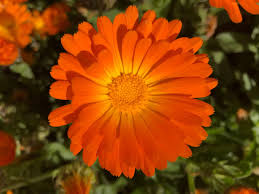
Calendula officinalis is an annual or shot-lived perennial herb in the daisy family. It has been used for many centuries for a range of culinary and medicinal purposes. This species has the common name ‘pot marigold’, which should not be confused with garden marigolds.
The bushy plants have simple, alternate leaves on angular, branched stems spreading up to 2 feet long. The stems are covered in fine hairs. The edges of the leaves are wavy but not toothed, and the leaves are sticky and aromatic.
The daisy-like flowers are typically bright orange or yellow. The plants bloom over a long period, almost continuously until the first heavy frost.
I grow calendula every year and absolutely love how easy it is and how good medicinally it is for the skin. I regularly make a comfrey and calendula salve for any type of wounds or skin issues, as lip balm, and as a soothing heel cream. It can be made into a tea, tincture, herbal oil, salve, etc.
Calendula has anti-inflammatory, antioxidant, antimicrobial, and anticancer properties and is also good to use for the following:
Skin conditions:
- Wounds: Calendula can help treat burns, bruises, cuts, and other wounds. It can also help with tissue regeneration and re-epithelialization.
- Dermatitis: Calendula can help prevent dermatitis and skin inflammation. It may also help with diaper dermatitis.
- Eczema: Some people use calendula oil to manage symptoms of eczema.
Other conditions
Leg ulcers: Calendula may help with venous and neuropathic leg ulcers.
Gingivitis: Calendula may help with gingivitis.
Vaginal candidiasis: Calendula may help with vaginal candidiasis.
Bacterial vaginosis: Calendula ointment may help with bacterial vaginosis.